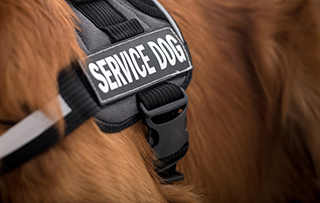
As a company that supports the veteran and military community, we’ve heard countless stories of how animals have helped veterans heal physical and emotional wounds—especially when those animals are of canine persuasion.
This week, we wanted to fetch a little more information on the matter. So, here are three ways service dogs help veterans—plus a little extra you might not know:
Increased Physical Capabilities
Dogs have been helping humans with daily tasks for millennia. Some scientists even believe dogs in ancient times helped modern humans outcompete Neanderthals. They alerted us to danger and aided us when we hunted food.
In modern times, people realized dogs could help humans in all sorts of ways. During WWI, the first training schools for service dogs were set up in Germany as a way to help veterans who’d been blinded in battle.
By the late 1920s, the idea of using dogs to help the visually impaired had spread to the U.S. The first school in America for these dogs, The Seeing Eye, was established in Nashville, Tennessee, in 1929. These dogs, known as guide dogs or seeing-eye dogs, help the visually impaired navigate obstacles such as curbs and stair steps.
Later, dog trainers realized their helpful hounds could also benefit people who are hearing impaired, alerting their owners to various sounds with a gentle nudge from their muzzles. And by the 1980s, dogs were being trained to help many other types of disabilities, as well. Today, common tasks for these animals include flipping on light switches, retrieving dropped objects, opening doors and serving as a brace when stability or balance is an issue. For veterans or anyone living with such disabilities, these furry friends have helped their owners reclaim mobility and a sense of independence.
Improved State of Mind
Dogs can also help one’s mental outlook. In 2018, researchers with Purdue University reported in a study that dogs can have a significantly positive effect on veterans living with post-traumatic stress disorder (PTSD).
In the study, researchers compared the mental states of PTSD veterans on a waiting list to receive specially trained dogs with the mental states of veterans who’d already taken ownership of such dogs. The veterans with dogs reported lower rates of depression, lower thoughts of suicide, a 22% higher rate of life satisfaction and a higher overall psychological wellbeing.
From a biological perspective, scientists are still trying to explain how this works. But many believe the presence of dogs—and other animals in the home—can help boost chemicals in the brain that make us feel better. Oxytocin, for one, reduces stress and helps increase one’s ability to trust and form bonds. And chemicals like dopamine, the “feel good” hormone, put us in good moods and help increase long-term memory.
Improved states of mind can also make it easier for veterans trying to recover from alcoholism and drug addiction.
Improved Social Life
The wartime experiences that many veterans have gone through commonly cause them to withdraw from social situation once they’re back in the civilian world. But dogs can help with this, too.
For one, dogs are great friends. They love us unconditionally, but they need us to take care of them, and this can help foster a sense of purpose. Many PTSD veterans say their four-legged friends have helped them overcome emotional numbness and come out of their shells.
Interacting with dogs and teaching them commands can help fine tune communication skills, as well—showing ways to be assertive without being aggressive, an issue commonly reported by those suffering from PTSD.
And dogs can also decrease hypervigilance, another symptom associated with PTSD. It’s much easier to get a good night’s sleep when you know your poochy pal is keeping watch or that he’s been taught to wake you from nightmares. Dogs can ease anxiety in social situations, too, creating space between their owners and strangers in public spaces or keeping an eye out for danger. Veterans with PTSD even report lower rates of missed work once they have dogs in their lives, according to the Purdue University study mentioned earlier.
Distinguishing Between Service Dogs and Emotional Support Dogs
When it comes to helping humans, experts group dogs into several different categories, though they all fall into two main groups: service dogs and emotional support dogs. Here’s a little more about these groups:
Service dogs/PTSD service dogs: According to the Americans with Disabilities Act (ADA), service dogs are specially trained to help the disabled in day-to-day tasks. The tasks performed must relate directly to the person’s disability. PTSD service dogs receive extra training aimed at dealing with PTSD—such as waking their owners from nightmares.
It’s common to see service dogs wearing special vests, harnesses, tags and collars, but the ADA doesn’t require this or any sort of identification. In fact, even though the ADA guarantees certain rights for these dogs and their owners (broad access to public spaces), the federal government issues no official certifications or licenses for them. The only requirements when out in public, if asked, is that the owner state that the animal is a service dog and list the tasks it’s trained to help with. This category includes guide dogs, hearing dogs, mobility assistance dogs and psychiatric service dogs.
Emotional support dogs: Also known as therapy or comfort dogs, these caring canines provide help just by being around their owners. They’re not required to have training in specific tasks, and they’re not granted the same access to public spaces that service dogs are. Federal law does grant them access on planes without extra fees for the owner, though some airlines have limits. And the law also allows owners to keep comfort dogs in housing where landlords don’t usually allow pets—and with no extra fees. In both cases, the dog owner may be asked to show proof in the form of a letter from a mental health professional that the dog is necessary.
Beyond Canine Companions
Dogs aren’t the only official service animals recognized by the ADA. Miniature horses, too, have made the cut. They’re most often used as guide animals for the visually impaired. But they’re also great at retrieving objects and helping their owners with stability and balance. And though they require more training than dogs, they live a lot longer—up to 35 years. They’re also not as social, which can mean they’re less likely to stray from their owners in public. They don’t shed as much as a dog, and they don’t get flees.
And when we look at animals that can provide emotional support, the list grows even longer. Ferrets, parrots, potbelly pigs, rabbits, rats, capuchin monkeys and, yes, even snakes have all been used as emotional support animals. The use of these animals isn’t without controversy, however. And requests to use some animals as emotional support animals can be denied, especially when it’s been determined that the animal is a danger or nuisance.


